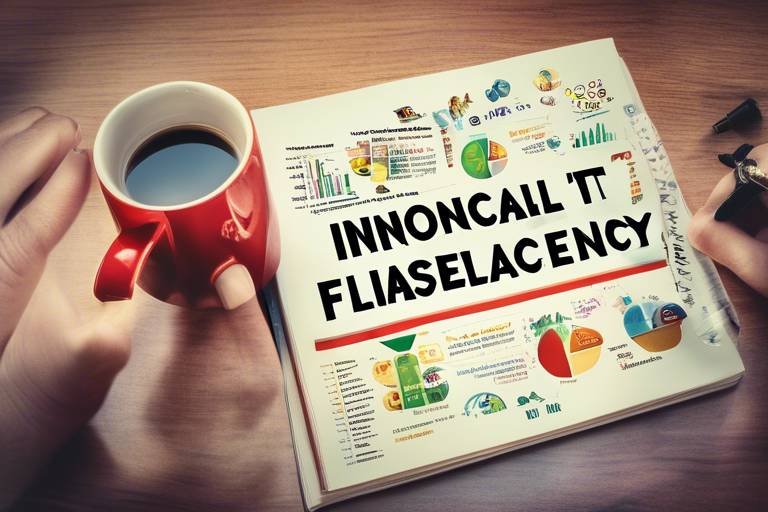The Benefits of Using Collaborative Tools in Research
In today's fast-paced world, the landscape of research is evolving rapidly, and the integration of collaborative tools has become a game changer. These tools are not just fancy gadgets; they are the backbone of modern research methodologies, enhancing productivity, fostering communication, and ensuring that projects are completed successfully. Imagine a scenario where researchers from different corners of the globe can work on a project as if they were sitting in the same room. This is the power of collaborative tools in research, and it opens up a world of opportunities that were once unimaginable.
Effective communication is the heartbeat of any research project. Without it, misunderstandings can lead to errors, wasted time, and frustration. Collaborative tools act as a bridge, facilitating real-time discussions among team members. Whether you're sharing ideas in a chatroom, participating in video calls, or commenting on documents, these tools ensure that everyone is on the same page. For instance, platforms like Slack and Microsoft Teams allow teams to communicate effortlessly, keeping everyone aligned and informed. This level of connectivity not only enhances the quality of research outcomes but also fosters a sense of belonging among team members.
Imagine being able to cut down on the hours spent on administrative tasks and instead focus on what truly matters—your research! That’s exactly what collaborative tools can do. By streamlining workflows, these tools reduce the time spent on mundane tasks, which can be a real productivity killer. For example, researchers can automate scheduling, organize files, and manage communications all in one place. This means more time for brainstorming, experimenting, and pushing the boundaries of knowledge. It’s like having a personal assistant who takes care of the nitty-gritty, allowing you to unleash your creativity and expertise.
Many collaborative tools come equipped with task management functionalities, which are crucial for keeping projects on track. Teams can assign responsibilities, set deadlines, and track progress with ease. This enhances accountability and ensures that everyone knows their role in the project. For instance, tools like Trello and Asana allow teams to create boards where tasks can be assigned and monitored visually. This not only keeps everyone accountable but also motivates team members to meet their deadlines and contribute actively to the project.
Visual tools, such as Kanban boards or Gantt charts, are particularly useful in research projects. They provide a snapshot of the project's progress at a glance, making it easy to identify bottlenecks and adjust plans accordingly. Imagine looking at a colorful chart that shows you exactly where you stand and what needs to be done next. This clarity can be incredibly motivating and helps teams stay focused on their goals.
Another significant advantage of collaborative tools is their ability to integrate with various applications. Whether it's syncing with your calendar to schedule meetings or linking to document management systems for easy access to research papers, these integrations simplify the workflow. This means that researchers can access all necessary resources from a single platform, eliminating the chaos of juggling multiple applications. It’s like having a one-stop shop for all your research needs!
In research, data is king. Collaborative tools promote seamless data sharing among team members, enabling faster access to information. This is crucial for informed decision-making and can significantly foster innovation. Imagine a scenario where a researcher in one part of the world can instantly share findings with a colleague halfway across the globe. This level of accessibility not only speeds up the research process but also encourages a culture of openness and collaboration.
Diversity is a powerful asset in research. Collaborative tools allow for the inclusion of team members from various backgrounds, promoting a variety of perspectives and ideas. This diversity can lead to more comprehensive and innovative research solutions. When different minds come together, they can challenge each other's assumptions and spark creativity in ways that a homogeneous group might not. It’s like mixing different colors on a palette to create a stunning masterpiece.
One of the most exciting aspects of collaborative tools is their ability to enable global collaboration. Researchers from different geographic locations can work together effortlessly, breaking down barriers and fostering international partnerships. This enhances the scope and impact of research, allowing for a richer exchange of ideas and methodologies. Imagine collaborating with a scientist in Japan while sitting in your office in the United States; the possibilities are endless!
Finally, adopting collaborative tools helps cultivate a culture of teamwork and shared responsibility. This culture encourages researchers to work together more effectively, fostering a sense of community within research environments. When team members feel supported and valued, they are more likely to contribute their best efforts. It's like being part of a sports team where everyone plays their role to achieve a common goal.
- What are collaborative tools? Collaborative tools are online platforms that enable teams to work together, share information, and communicate effectively, regardless of their physical location.
- How do collaborative tools improve productivity? By streamlining workflows, automating tasks, and providing a centralized platform for communication and data sharing, collaborative tools help researchers focus more on their core objectives.
- Can collaborative tools enhance communication? Yes! They facilitate real-time discussions, ensuring that all team members are aligned and informed, which ultimately leads to better research outcomes.
- What role does diversity play in collaborative research? Diverse perspectives can lead to more innovative solutions and comprehensive research outcomes, enriching the overall quality of the work.

Improved Communication
Effective communication is the backbone of any successful research project. Imagine trying to complete a puzzle without having all the pieces; that’s what research can feel like without proper communication. Collaborative tools serve as the glue that holds the project together, allowing team members to engage in real-time discussions, share insights, and provide feedback instantly. This not only ensures that everyone is on the same page but also enhances the overall quality of the research outcomes.
Think about it: when researchers can communicate openly and frequently, they can address issues as they arise, brainstorm ideas together, and refine their approaches based on collective input. This dynamic exchange of information can transform a research project from a solitary endeavor into a vibrant collaborative experience. For instance, platforms like Slack or Microsoft Teams allow teams to create dedicated channels for specific topics, making it easier to keep discussions organized and accessible.
Moreover, collaborative tools often come equipped with features that facilitate asynchronous communication. This means that even if team members are in different time zones, they can still contribute effectively. By utilizing features such as threaded conversations and comment sections, researchers can leave notes for one another, ensuring that important discussions are not lost in the shuffle. This level of communication fosters a sense of community and shared responsibility, where everyone feels valued and heard.
To illustrate the impact of improved communication, consider the following benefits:
- Clarity: Clear communication minimizes misunderstandings and clarifies expectations, leading to more focused research efforts.
- Speed: Real-time discussions expedite decision-making processes, allowing researchers to pivot quickly when necessary.
- Engagement: When team members communicate effectively, they are more likely to feel engaged and motivated, enhancing overall morale.
In conclusion, the role of communication in research cannot be overstated. By leveraging collaborative tools, researchers can create a more connected and informed team environment. This not only leads to better research outcomes but also cultivates a culture of collaboration that extends beyond individual projects. When communication flows freely, innovation thrives, and the possibilities for groundbreaking discoveries become limitless.

Increased Productivity
In today’s fast-paced research environment, boosting productivity is more important than ever. Collaborative tools have emerged as game-changers in this regard, offering features that streamline workflows and minimize the time spent on mundane administrative tasks. Imagine being able to focus on your core objectives without the constant distraction of managing emails or organizing meetings. Sounds appealing, right? Well, that’s exactly what these tools provide!
One of the most significant advantages of collaborative tools is their task management functionalities. These features allow teams to assign specific responsibilities to each member, set clear deadlines, and track progress in real-time. This not only enhances accountability but also ensures that everyone is on the same page. Picture this: instead of sending back-and-forth emails about who’s responsible for what, you can simply check a dashboard and see the status of each task in an instant. This clarity not only saves time but also reduces the chances of miscommunication.
Moreover, many collaborative tools offer visual progress tracking features, such as Kanban boards or Gantt charts. These visual aids allow teams to monitor their progress at a glance, making it easier to identify bottlenecks and adjust plans accordingly. For instance, if a particular task is lagging behind, the team can quickly pivot and allocate resources to ensure that deadlines are met. This proactive approach is essential for maintaining momentum in research projects.
Additionally, the integration capabilities of these tools further enhance productivity. Collaborative platforms often connect seamlessly with other applications, such as calendars and document management systems. This means researchers can access all necessary resources from a single interface, eliminating the need to switch between multiple platforms. Imagine having your calendar, documents, and communication tools all in one place—it’s like having a personal assistant dedicated to keeping you organized!
In summary, the impact of collaborative tools on productivity is undeniable. By streamlining workflows, enhancing task management, and facilitating seamless integrations, these tools enable researchers to concentrate on what truly matters: delivering high-quality research outcomes. As we continue to embrace technology in research, the potential for increased productivity will only grow, paving the way for innovative discoveries and advancements.
- What are collaborative tools? Collaborative tools are software applications that enable teams to work together more efficiently, facilitating communication, task management, and data sharing.
- How do collaborative tools improve productivity? They streamline workflows, reduce administrative tasks, and allow for real-time progress tracking, enabling researchers to focus on their core objectives.
- Can collaborative tools be integrated with other applications? Yes, many collaborative tools offer integration capabilities with various applications like calendars and document management systems, simplifying the workflow.
- Are collaborative tools suitable for remote teams? Absolutely! They are designed to promote collaboration regardless of geographic location, making them ideal for remote teams.

Task Management Features
When it comes to research, managing tasks efficiently is like having a well-tuned engine in a race car; it keeps everything running smoothly and ensures that you reach the finish line on time. Collaborative tools come packed with that can transform how research teams operate. Imagine being able to assign specific tasks to team members, set clear deadlines, and track progress all in one place. This level of organization not only enhances accountability but also empowers team members to take ownership of their responsibilities.
One of the standout features is the ability to create task lists that can be customized according to the needs of your project. For instance, you can categorize tasks based on their priority level or the phase of research they belong to. This means that whether you’re in the brainstorming stage or knee-deep in data analysis, you can keep everything organized and accessible. Additionally, some tools even allow you to attach relevant documents or links to each task, ensuring that everyone has the information they need right at their fingertips.
Moreover, visual progress tracking is a game changer. Tools like Kanban boards or Gantt charts provide a visual representation of who is doing what and how far along each task is. This not only makes it easier to identify bottlenecks but also encourages team members to stay motivated as they see their progress unfold visually. Imagine a team member moving a task from "In Progress" to "Completed"—it’s a small victory that can boost morale!
To illustrate the effectiveness of these task management features, consider the following table that highlights key functionalities:
| Feature | Description | Benefits |
|---|---|---|
| Task Assignment | Allocate tasks to specific team members. | Enhances accountability and clarity. |
| Deadline Setting | Establish deadlines for each task. | Ensures timely completion of research projects. |
| Progress Tracking | Monitor the status of tasks visually. | Identifies bottlenecks and boosts motivation. |
| Document Attachment | Link relevant documents to tasks. | Provides easy access to necessary resources. |
By integrating these task management features into your research workflow, you not only streamline operations but also foster a collaborative environment where everyone is on the same page. The result? A more efficient, productive, and ultimately successful research project.
- What are collaborative tools?
Collaborative tools are software applications that enable teams to work together more effectively, often through features like file sharing, communication, and task management. - How do task management features improve research?
Task management features help organize tasks, set deadlines, and track progress, which enhances accountability and ensures timely project completion. - Can collaborative tools be used for remote teams?
Absolutely! Collaborative tools are designed to facilitate communication and teamwork, making them ideal for remote research teams.

Visual Progress Tracking
In the fast-paced world of research, keeping track of progress is essential for ensuring that projects stay on schedule and meet their objectives. tools, such as Kanban boards and Gantt charts, provide a clear and engaging way to visualize the workflow of a research project. Imagine being able to see your entire project at a glance, with each task represented as a colorful card or bar on a timeline. This not only makes the process more enjoyable but also significantly enhances the team's ability to identify bottlenecks and adjust plans as needed.
For instance, a Kanban board allows team members to move tasks from one column to another as they progress, creating a dynamic visual representation of the project's status. This method not only fosters accountability but also encourages collaboration, as everyone can see what others are working on and where support might be needed. Additionally, Gantt charts provide a timeline view of the project, showing how tasks overlap and the overall schedule, making it easier to manage deadlines and resources effectively.
Furthermore, these visual tools can be integrated with other collaborative platforms, allowing for real-time updates and feedback. This means that as soon as a task is completed, it can be reflected on the board or chart, keeping everyone in the loop. The ability to visualize progress in such a straightforward manner can be a game-changer for research teams, enabling them to stay organized and focused on their goals.
To illustrate the impact of visual progress tracking, consider the following table showcasing the benefits of using Kanban boards versus traditional methods:
| Feature | Kanban Board | Traditional Method |
|---|---|---|
| Real-Time Updates | ✔️ | ❌ |
| Visual Representation | ✔️ | ❌ |
| Team Collaboration | ✔️ | ❌ |
| Ease of Use | ✔️ | ❌ |
In conclusion, visual progress tracking not only enhances the efficiency of research teams but also makes the entire process more engaging and transparent. By utilizing these tools, researchers can ensure they remain on track, adapt to challenges swiftly, and ultimately achieve their project goals with greater success.
- What are collaborative tools? Collaborative tools are digital platforms that enable teams to work together on projects, share information, and communicate effectively, regardless of their physical location.
- How do visual progress tracking tools work? Visual progress tracking tools use graphical representations, such as boards or charts, to display the status of tasks and projects, making it easier for teams to monitor progress and identify issues.
- Can visual tracking tools improve team productivity? Yes, by providing a clear overview of tasks and responsibilities, these tools help teams stay organized and focused, ultimately boosting productivity.
- Are there any free visual tracking tools available? Yes, there are several free options available, such as Trello for Kanban boards and GanttProject for Gantt charts, which can be used effectively for research projects.

Integrations with Other Tools
In today’s fast-paced research environment, the ability to seamlessly integrate various tools can be a game changer. Collaborative tools often come equipped with integrations that connect with other essential applications, such as calendars, document management systems, and data analysis software. This interconnectedness not only streamlines workflows but also enhances the overall efficiency of research projects.
Imagine trying to juggle multiple platforms for communication, document sharing, and project management. It can feel like trying to solve a Rubik's Cube blindfolded! However, when collaborative tools integrate with your existing systems, it’s like having a personal assistant who organizes everything for you. For instance, when your collaborative tool syncs with your calendar, you can easily schedule meetings and deadlines without the hassle of switching between apps. This means less time spent on logistics and more time focused on what truly matters: the research itself.
Moreover, these integrations allow for real-time updates and notifications, ensuring that all team members are kept in the loop. When changes are made to a document or a task is completed, everyone involved gets notified instantly. This level of transparency is crucial in research, where even the smallest detail can impact the outcome of a project. With the right integrations, you can create a cohesive environment where information flows freely, and collaboration happens naturally.
To illustrate the benefits of these integrations, let’s take a look at a few popular tools that researchers often use:
| Collaborative Tool | Integration Features |
|---|---|
| Slack | Integrates with Google Drive, Trello, and Zoom for seamless communication and file sharing. |
| Trello | Connects with apps like Google Calendar and Slack, enhancing project management and scheduling. |
| Google Drive | Allows integration with various project management tools and communication platforms for easy access to documents. |
By leveraging these integrations, researchers can create a more unified and efficient workflow. The ability to access all necessary resources from one central location not only saves time but also reduces the likelihood of errors and miscommunication. In a world where every minute counts, having integrated tools at your disposal can significantly enhance your research outcomes.
In conclusion, the integration of collaborative tools with other applications is not just a luxury; it's a necessity for modern researchers. It fosters a more productive environment, encourages teamwork, and ultimately leads to more successful research projects. So, if you haven’t already, it’s time to explore how these integrations can revolutionize your research process!
- What are collaborative tools? Collaborative tools are software applications that enable teams to work together more effectively, facilitating communication, project management, and data sharing.
- How do integrations improve research productivity? Integrations streamline workflows by connecting various applications, reducing the time spent on administrative tasks and allowing researchers to focus on their core objectives.
- Can I use collaborative tools for remote research teams? Absolutely! Collaborative tools are designed to support remote collaboration, making it easier for teams from different locations to work together.

Enhanced Data Sharing
In the fast-paced world of research, data sharing is not just a luxury; it’s a necessity. Collaborative tools have transformed how researchers exchange information, making it easier than ever to access and share critical data. Imagine a vibrant marketplace where ideas and insights flow freely—this is what effective data sharing in research feels like. With just a few clicks, team members can upload, download, and collaborate on datasets, ensuring that everyone is on the same page and has the most current information at their fingertips.
One of the most significant advantages of enhanced data sharing is the speed it brings to the research process. When data is readily available, researchers can make informed decisions quickly, reducing the time spent on back-and-forth communications. This seamless access to information not only boosts efficiency but also fosters a culture of innovation. When researchers can easily share their findings, they can build upon each other’s work, leading to groundbreaking discoveries that might not have been possible in a more isolated environment.
Furthermore, collaborative tools often come equipped with features that facilitate data organization and management. For example, many platforms allow users to categorize and tag datasets, making it easier to locate specific information when needed. This organized approach can significantly reduce the time spent searching for data, allowing researchers to focus on analysis and interpretation. Here’s a quick look at some of the key features that enhance data sharing:
| Feature | Description |
|---|---|
| Real-Time Collaboration | Allows multiple users to work on the same dataset simultaneously, making updates visible instantly. |
| Version Control | Tracks changes made to datasets, ensuring that researchers can revert to previous versions if necessary. |
| Access Permissions | Enables researchers to control who can view or edit data, enhancing security and privacy. |
| Data Visualization Tools | Provides graphical representations of data, making it easier to understand and analyze trends. |
Additionally, collaborative tools often support various file formats, allowing researchers to share everything from spreadsheets to complex datasets without compatibility issues. This flexibility is crucial in a field where diverse data types are the norm. By breaking down barriers to data sharing, these tools not only enhance individual projects but also contribute to the broader research community, enabling a more collaborative and interconnected approach to knowledge creation.
In conclusion, enhanced data sharing through collaborative tools is a game-changer in the research landscape. It empowers teams to work more effectively, encourages innovation, and ultimately leads to better research outcomes. By embracing these tools, researchers can ensure they are not just participants in their field but active contributors to the ever-evolving tapestry of knowledge.
- What are collaborative tools? Collaborative tools are software applications that facilitate teamwork and communication among researchers, allowing for efficient data sharing and project management.
- How do collaborative tools improve data sharing? They provide real-time access to data, enhance organization, and allow for easy updates and modifications by multiple users.
- Can collaborative tools be used for remote teams? Absolutely! These tools are designed to support collaboration across geographic boundaries, making them ideal for remote research teams.
- Are there security concerns with data sharing? While there are always risks, most collaborative tools offer robust security features like access permissions and encryption to protect sensitive data.

Encouragement of Diverse Perspectives
When it comes to research, the phrase “two heads are better than one” couldn't be more accurate. Collaborative tools play a pivotal role in fostering an environment where diverse perspectives can flourish. By bringing together individuals from different backgrounds, experiences, and areas of expertise, these tools create a melting pot of ideas that can lead to groundbreaking discoveries. Imagine a team of researchers tackling a complex problem; each member contributes unique insights that, when woven together, form a rich tapestry of understanding. This diversity not only enhances creativity but also drives innovation, as varied viewpoints often lead to novel solutions.
One of the remarkable aspects of collaborative tools is their ability to bridge geographical divides. Researchers from all over the world can connect seamlessly, allowing for a global exchange of ideas and knowledge. For instance, a scientist in Europe can collaborate with a researcher in Asia, combining their cultural and academic perspectives to tackle a shared problem. This kind of collaboration is invaluable, as it encourages teams to think outside their usual frameworks and consider alternative approaches that they may not have encountered otherwise.
Moreover, diverse teams are often more effective at problem-solving. According to studies, groups composed of individuals with varied backgrounds tend to outperform homogenous teams. This can be attributed to the fact that different perspectives challenge assumptions and stimulate critical thinking. In a research context, this means that the likelihood of identifying potential pitfalls or blind spots increases significantly. Collaborative tools empower teams to harness these diverse perspectives effectively, ensuring that every voice is heard and valued.
To illustrate the impact of diverse perspectives in research, consider the following benefits:
- Enhanced creativity: Different viewpoints can spark innovative ideas that might not emerge in a uniform group.
- Improved decision-making: A variety of perspectives leads to more thorough discussions and better-informed choices.
- Broader understanding: Collaborating across disciplines allows researchers to gain insights that enrich their work.
In conclusion, the encouragement of diverse perspectives through collaborative tools is not just a bonus; it is a necessity in today’s research landscape. As we continue to face complex global challenges, the ability to work together, leveraging our differences, will be crucial for success. By embracing these tools, researchers can cultivate an inclusive environment that not only values diversity but actively seeks it out, ultimately leading to richer, more impactful research outcomes.
Q1: How do collaborative tools enhance communication in research?
A1: Collaborative tools facilitate real-time discussions, allowing team members to share ideas and feedback instantly, which keeps everyone aligned and informed.
Q2: Can collaborative tools improve productivity?
A2: Yes, by streamlining workflows and reducing time spent on administrative tasks, researchers can focus more on their core objectives and deliverables.
Q3: What are some examples of collaborative tools?
A3: Examples include platforms like Slack, Trello, and Google Workspace, which offer features for communication, task management, and document sharing.
Q4: How do diverse perspectives influence research outcomes?
A4: Diverse perspectives enhance creativity and problem-solving capabilities, leading to more innovative and comprehensive research solutions.

Global Collaboration Opportunities
In today's interconnected world, the potential for global collaboration in research has never been more significant. Thanks to collaborative tools, researchers can easily connect with peers from different corners of the globe, transcending geographical boundaries. Imagine being able to brainstorm with a scientist in Tokyo while sipping coffee in your local café! This level of connectivity not only enhances the research process but also enriches it with a variety of insights and experiences.
One of the most exciting aspects of global collaboration is the access to a diverse pool of knowledge and expertise. When researchers from various backgrounds come together, they bring unique perspectives that can lead to innovative solutions. For instance, a team composed of environmental scientists from Brazil, engineers from Germany, and data analysts from India can tackle climate change challenges from multiple angles, resulting in comprehensive strategies that might not have emerged in a more homogeneous group.
Moreover, collaborative tools facilitate real-time communication and data sharing, allowing teams to work on research projects simultaneously, regardless of their physical locations. With features like video conferencing, instant messaging, and shared document editing, researchers can conduct meetings, share findings, and make decisions swiftly. This immediacy can significantly accelerate the research timeline, enabling teams to respond to challenges and opportunities quickly.
To illustrate the impact of global collaboration, consider the following table that highlights some key benefits:
| Benefit | Description |
|---|---|
| Access to Expertise | Collaborating globally allows researchers to tap into specialized knowledge that may not be available locally. |
| Diverse Perspectives | Different cultural and academic backgrounds foster creativity and innovation. |
| Resource Sharing | Teams can share materials and tools, enhancing the overall quality of research. |
| Networking Opportunities | Global collaborations can lead to lasting professional relationships and future partnerships. |
Furthermore, these tools can help establish international partnerships, which can be crucial for securing funding and resources. Many funding bodies are increasingly looking for collaborative projects that demonstrate a global impact. By working together across borders, researchers can pool their resources, share costs, and increase their chances of obtaining grants.
In conclusion, the rise of collaborative tools has opened up a world of possibilities for researchers. The ability to collaborate globally not only enhances the quality and scope of research but also fosters a sense of community among scientists worldwide. As we continue to tackle complex global challenges, embracing these collaboration opportunities will be essential for driving innovation and achieving impactful results.
- What are collaborative tools? Collaborative tools are digital platforms that enable individuals to work together on projects, share information, and communicate effectively, regardless of their physical location.
- How can global collaboration benefit research? Global collaboration brings together diverse perspectives, enhances resource sharing, and fosters innovation, leading to more comprehensive research outcomes.
- What types of collaborative tools are available for researchers? There are various collaborative tools available, including project management software, communication platforms, and data sharing systems.
- Can global collaboration help in securing research funding? Yes, many funding organizations prefer projects that demonstrate international collaboration, as they often yield broader impacts.

Building a Collaborative Culture
When it comes to research, the environment in which we work can make all the difference. A collaborative culture within a research team is essential for fostering creativity, innovation, and a sense of shared purpose. But how do we cultivate this culture? It all starts with the right tools and mindset. By embracing collaborative tools, teams can create an atmosphere that encourages open communication and mutual support.
One of the key benefits of using collaborative tools is that they help break down the barriers that often exist in traditional research settings. Imagine a scenario where team members are scattered across different locations. Without the right tools, communication can become fragmented, leading to misunderstandings and delays. However, with collaborative platforms, researchers can connect in real-time, share ideas, and provide feedback instantly. This not only enhances productivity but also builds trust among team members.
Moreover, a collaborative culture thrives on diversity. When researchers from different backgrounds and areas of expertise come together, they bring unique perspectives that can lead to groundbreaking ideas. Collaborative tools facilitate the inclusion of these diverse voices, allowing everyone to contribute to discussions and decision-making processes. This inclusivity can spark creativity and lead to innovative solutions that might not have emerged in a more isolated setting.
To further nurture this collaborative spirit, it's essential to establish clear guidelines and expectations. Teams should openly discuss their goals, roles, and responsibilities to ensure everyone is on the same page. This can be easily managed through task management features available in collaborative tools, where team members can assign tasks, set deadlines, and track progress. Such transparency not only fosters accountability but also encourages team members to support each other in achieving their objectives.
Another important aspect of building a collaborative culture is recognizing and celebrating achievements, both big and small. When team members feel valued for their contributions, it boosts morale and motivates them to continue collaborating. Consider implementing a recognition system within your collaborative tools, where you can highlight individual and team successes. This simple practice can significantly enhance team cohesion and encourage ongoing collaboration.
Lastly, it's crucial to provide ongoing training and support for team members to effectively use collaborative tools. Not everyone may be familiar with the latest technologies, and a little guidance can go a long way in ensuring everyone feels comfortable and capable. Regular workshops or training sessions can empower researchers to utilize these tools to their fullest potential, ultimately fostering a more collaborative environment.
In conclusion, building a collaborative culture in research is not just about using the right tools; it's about creating an environment where team members feel connected, valued, and motivated to work together. By embracing collaboration, teams can unlock new levels of creativity and innovation, paving the way for successful research outcomes.
- What are collaborative tools? Collaborative tools are software applications that enable teams to work together more efficiently, facilitating communication, sharing of resources, and project management.
- How do collaborative tools improve research outcomes? They enhance communication, streamline workflows, and foster diverse perspectives, all of which contribute to more effective and innovative research.
- Can collaborative tools be used for remote teams? Absolutely! Collaborative tools are designed to support teams regardless of their geographical locations, making remote collaboration seamless.
- What is the importance of a collaborative culture? A collaborative culture encourages teamwork, creativity, and shared responsibility, leading to better research outcomes and a more positive work environment.
Frequently Asked Questions
-
What are collaborative tools in research?
Collaborative tools are software applications that enable researchers to work together efficiently, regardless of their physical locations. These tools help facilitate communication, data sharing, and project management, making it easier for teams to collaborate on research projects.
-
How do collaborative tools improve communication?
Collaborative tools enhance communication by providing real-time messaging, video conferencing, and shared document editing. This ensures that all team members can stay aligned and informed, leading to better research outcomes and fewer misunderstandings.
-
Can collaborative tools increase productivity?
Absolutely! By streamlining workflows and reducing time spent on administrative tasks, collaborative tools allow researchers to focus on their core objectives. Features like task management and progress tracking contribute to a more efficient research process.
-
What task management features do these tools offer?
Many collaborative tools include features such as task assignment, deadline setting, and progress tracking. These functionalities help teams stay organized, enhance accountability, and ensure timely completion of research projects.
-
How can visual progress tracking help research teams?
Visual progress tracking tools, like Kanban boards or Gantt charts, provide a quick overview of project status. They help teams identify bottlenecks and adjust plans accordingly, ensuring that projects stay on track and deadlines are met.
-
Do collaborative tools integrate with other applications?
Yes, many collaborative tools offer integrations with calendars, document management systems, and other applications. This simplifies workflows, allowing researchers to access all necessary resources from a single platform.
-
How do collaborative tools enhance data sharing?
Collaborative tools promote seamless data sharing by allowing team members to access and share information quickly. This fast access to data is crucial for informed decision-making and fosters innovation in research.
-
Can these tools facilitate global collaboration?
Definitely! Collaborative tools break down geographical barriers, enabling researchers from different locations to work together effortlessly. This fosters international partnerships, enhancing the scope and impact of research.
-
What is the impact of collaborative tools on research culture?
Adopting collaborative tools helps build a culture of teamwork and shared responsibility. They encourage researchers to collaborate more effectively, fostering a sense of community within research environments.

















